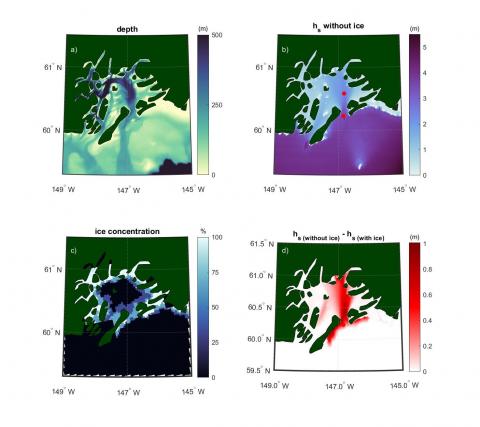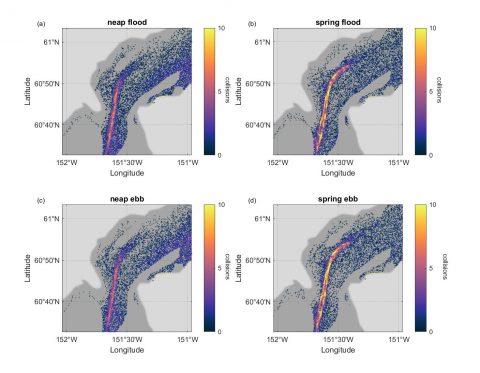Sea-Ice Effects
Sea ice is a seasonal phenomenon along the Alaskan coastline. In winter, ice forms on most of the coastline, whereas by fall it has completely melted away. This ice dampens wave energy that could be used by a wave energy convertor and is a collision risk for tidal turbine installations. Researchers from the Ocean Dynamics Modeling group are using numerical models to study wave dampening due to sea ice and estimate the collision risks of drifting sea ice.

Projects
Sea-ice effects on waves
Sea-ice effects on waves were studied with a high-resolution SWAN waves model for Prince William Sound in Alaska. Daily sea-ice concentration data were obtained from the AMSR-2 satellite instrument and input to the model. The model was validated with wave data from a buoy at the mouth of Prince William Sound and one inside the Sound. Sea ice was found to form around the coastline of Prince William Sound and occasionally blocked its entrance. The ice dampened waves at the mouth and inside the Sound, decreasing the wave energy that could be captured by a wave energy convertor.

Risk Analysis of Drifting Sea Ice on Tidal Energy Project Siting
Cook Inlet has great potential for tidal stream energy development. However, the presence of drifting sea ice could create hazardous collision risk for the deployment of tidal turbine farms for power generation. Before tidal turbines can be installed in Cook Inlet, sites must be surveyed to determine how often sea ice is present, how fast it will be moved by the current, and where the trajectories of drifting sea ice will be concentrated. In this study, we use remotely sensed data to characterize the seasonal sea ice conditions in Cook Inlet, a hydrodynamic model to map the water velocities, and a particle tracking model to calculate collision risks. The resulting sea ice coverage and collision risk maps will enable tidal energy developers to choose the best locations for the deployment of tidal turbines and other offshore platforms in Cook Inlet.

This work was funded by the Department of Energy Water Power Technologies Office.